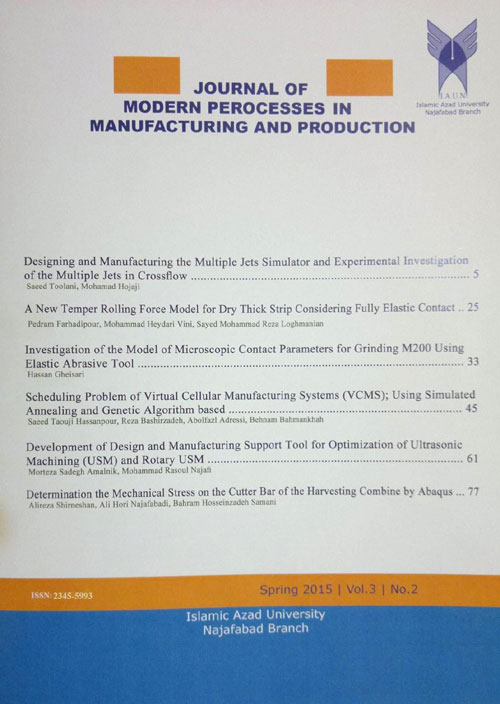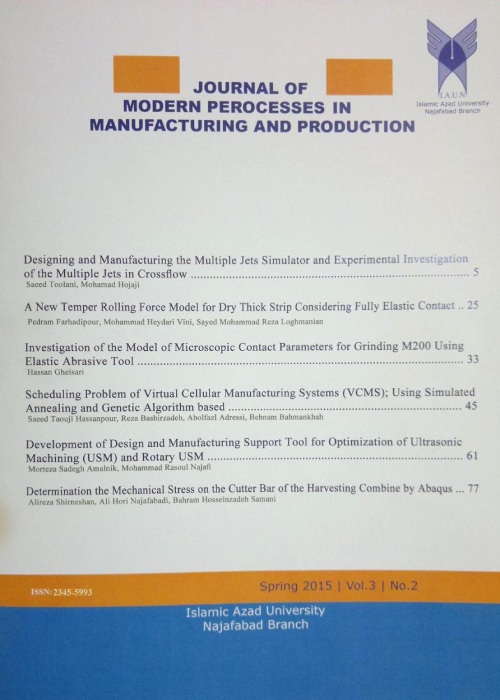فهرست مطالب

Journal of Modern Processes in Manufacturing and Production
Volume:10 Issue: 2, Spring 2021
- تاریخ انتشار: 1400/06/18
- تعداد عناوین: 6
-
-
Pages 5-12Hydromechanical deep drawing is a new process in sheet metal forming. In hydromechanical deep drawing, a chamber of fluid replaces the matrix and the final form of part is determined based on the form of rigid punch. This process can produce parts with more drawing ratios than traditional deep drawing. In this paper, the hydromechanical deep drawing (HDD) of square parts was studied using the finite element method (FEM), and the effects of different parameters of the process such as pre-bulging pressure, chamber pressure, and friction coefficient on the thinning were investigated. Simulation is done using Abaqus software. St12 sheets have been formed and the effect of parameters on thickness distribution is determined. A study was also carried out using an experimental setup to verify the FEM results. Results show that flange wrinkling decreases by increasing chamber pressure. Also selecting appropriate pre-bulging pressure can decrease the thinning significantly. Finally, the numerical results were compared with experimental data.Keywords: Hydromechanical Deep Drawing, Drawing Ratio, Thinning
-
Pages 13-26The capability to receive and deliver customer demand on time in today's competitive world is a significant concern for all industries. In particular, demand management has entered a new era with many companies competing in the last decade. Customer demand management is one of the contemporary issues. The main goal of demand management is to improve supply chain effectiveness, and it is important to note that it is complementary to distribution management and product demand management. Therefore, demand forecasting is essential. For this purpose, in this study, the modeling of the combination structure using autoregressive integrated moving average models and multilayer perceptron neural networks in the field of demand with benchmark data is investigated. The data sets used in this study are two well-known benchmarks of the total product revenue of the Taiwan machinery industry and the sales volume of soft drinks. Eviews and Matlab software have been used to determine the unknown parameters of the proposed model. The experimental results of the research show that the performance of the proposed hybrid model is more accurate than its single components. In addition, results indicate that intelligent models can perform better than classic statistical models.Keywords: Seasonal Autoregressive Integrated Moving Average (SARIMA), Seasonal Artificial Neural Network (SANN), Demand Forecast
-
Pages 27-39Equal channel angular pressing is one of the most popular processes for the fabrication of ultrafine-grained (UFG) materials. Homogeneous strain distribution is one of the main expected outputs in this process. Recently, a new modification has been applied on the ECAP die in which the workpiece undergoes twisting in the exit channel which is defined as the helix angle of the die. In this paper, the effect of the helix angle in the exit channel along with other effective parameters, including friction coefficient and die channel angle was investigated by the FEM method. At first, a FEM model was developed based on available experimental data. Having verified the FEM model, Taguchi's design of the experimental approach was employed in which the helix angle and friction coefficient had four levels and the die channel angle had two levels. Evaluating the obtained results by the ANOVA method showed that the p-value of the helix angle was 0.01 i.e., the helix angle was an effective parameter on strain distribution and maximum imposed strain. The results also showed that the homogeneity of strain distribution decreases with increasing the friction coefficient and the helix angle and increases with increasing the die channel angle. Also, increasing the helix angle led to an increase in the maximum imposed strain.Keywords: ECAP, Helix angle, Frictional Coefficient, Die Angle, Taguchi approach, Homogeneity
-
Pages 41-51In today's manufacturing processes, production optimization is very important to increase the competitive edge, so production managers are hardly trying to increase their production output (without increasing resources) by using different manufacturing processes and different fields of industrial engineering. These methods are used in productivity and decrease the cost of goods sold, which managers favor in all companies. This paper investigated the optimization problem in a flow shop production line with the probable time and the other constraints such as limited equipment, manufacturing process limit, by using scheduling techniques and creating a learning system by simulating. We use a simulation-based optimization approach that combines simulation and exact methods to solve the Flow Shop Scheduling problem. simulation software used to reduce the constraints and exact model used for optimizing answers that can be efficient and effective. Implementing this model with all its probable components in a high-tech pharmaceutical company with many different products increases utilization and largely to those outputs have increased by 12%.Keywords: production, Simulation, Optimization, Bottlenecks, Queuing Systems
-
Pages 53-62Al-Si alloys are widely used in the manufacture of automotive parts such as pistons and cylinders. Although it has desired properties for use in pistons, some microstructural properties of this alloy, such as dendrites or the presence of needle-like silicones, reduce the performance of the parts produced. In this research, to modify the microstructural properties and thus improve the mechanical properties of the alloy, the friction stir processing (FSP) method is used. Also, the effect of process parameters such as rotational and traverse speeds as well as the shape of the pin on the microstructural and mechanical properties of the samples, are studied. The results show that the FSP process improves the microstructural properties of the base metal, and thus improves its mechanical properties. Furthermore, by increasing the rotational speed or decreasing the traverse speed of the tool, the silicon particles become finer, and consequently, the microstructural properties are improved.Keywords: FSP, Microstructure, Piston Alloy, Pin Shape
-
Pages 63-70This paper points out some errors based on the one-dimensional Taylor series for a multi-dimensional function that is used for robots manufacturing. It is argued that the proof of theorem 1 is not mathematically true, and consequently, the obtained results cannot be correct. In addition to this, the stability analysis presented in the paper does not address the saturated area properly. Therein, stability is analyzed separately in saturated and unsaturated operation areas. However, the stability of the closed-loop system may not be guaranteed through these separate analyses, since transitions from saturation area to unsaturated area and vice versa are neglected. This work is an extension of the above paper, based on the revised Taylor series and considering actuator saturation limit in both controller design and stability analysis.Keywords: Adaptive Uncertainty Estimation, Actuator Saturation, Stone-Weierstrass Theorem, Taylor series


